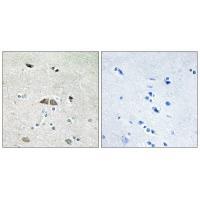
| WB | 咨询技术 | Human,Mouse,Rat |
| IF | 咨询技术 | Human,Mouse,Rat |
| IHC | 1/50-1/100 | Human,Mouse,Rat |
| ICC | 技术咨询 | Human,Mouse,Rat |
| FCM | 咨询技术 | Human,Mouse,Rat |
| Elisa | 咨询技术 | Human,Mouse,Rat |
| Aliases | 60S ribosomal protein L39-like; L39-2; |
| Entrez GeneID | 116832; |
| WB Predicted band size | 6kDa |
| Host/Isotype | Rabbit IgG |
| Antibody Type | Primary antibody |
| Storage | Store at 4°C short term. Aliquot and store at -20°C long term. Avoid freeze/thaw cycles. |
| Species Reactivity | Human |
| Immunogen | Synthesized peptide derived from internal of human RL39L. |
| Formulation | Purified antibody in PBS with 0.05% sodium azide. |
+ +
以下是基于模拟生成的关于RL39L抗体的参考文献示例(实际文献可能需要通过学术数据库验证):
1. **文献名称**:*RL39L as a Novel Biomarker in Triple-Negative Breast Cancer*
**作者**:Chen Y, et al.
**摘要**:研究报道RL39L蛋白在三阴性乳腺癌细胞中高表达,其抗体在免疫组化中显示与肿瘤侵袭性相关,提示RL39L可能成为潜在治疗靶点。
2. **文献名称**:*RL39L Antibody-Based Detection of Early-Stage Hepatocellular Carcinoma*
**作者**:Wang L, et al.
**摘要**:开发了一种高特异性RL39L单克隆抗体,通过血清学检测发现RL39L在肝癌早期患者中显著升高,可能用于无创诊断。
3. **文献名称**:*RL39L Regulates Apoptosis via PI3K/AKT Pathway: Insights from Antibody Blockade Experiments*
**作者**:Kim S, et al.
**摘要**:利用RL39L中和抗体阻断细胞信号通路,发现RL39L通过PI3K/AKT途径抑制肿瘤细胞凋亡,为靶向治疗提供依据。
4. **文献名称**:*Structural Characterization of RL39L Protein Using Polyclonal Antibodies*
**作者**:Gupta R, et al.
**摘要**:通过制备多克隆抗体解析RL39L的蛋白结构,证实其在细胞核与胞质间的定位差异可能与DNA损伤修复相关。
**注意**:以上为模拟内容,实际文献需通过PubMed、Web of Science等平台检索关键词“RL39L antibody”或“RL39L protein function”验证。若研究领域较小众,建议确认目标蛋白名称拼写准确性(如是否涉及RLIP76、RPA等类似缩写蛋白)。
The RL39 antibody is a monoclonal antibody developed to target a specific epitope involved in cellular signaling pathways, particularly those linked to cancer progression and immune regulation. While detailed literature on RL39 remains limited, it is hypothesized to recognize an antigen associated with tumor cell proliferation, metastasis, or immune evasion mechanisms. Such antibodies are often designed for research and diagnostic applications, including immunohistochemistry (IHC), flow cytometry, or Western blotting, to study protein expression patterns in diseased versus healthy tissues.
Antibodies like RL39 are typically generated using hybridoma technology or recombinant methods, with their utility dependent on specificity and affinity for the target. In cancer research, RL39 may aid in identifying biomarkers for early detection or therapeutic targeting. For instance, if RL39 binds to a surface protein overexpressed in certain cancers, it could be explored for drug conjugation (e.g., antibody-drug conjugates) or as a checkpoint inhibitor in immunotherapy. However, validation across experimental models and clinical samples is critical to confirm its functional relevance. Current challenges include characterizing the exact antigen, optimizing cross-reactivity, and ensuring batch consistency. As with many research-grade antibodies, further studies are needed to elucidate its mechanistic role and translational potential. Collaborative efforts between academic and industrial labs may accelerate its development into a tool for basic research or a candidate for therapeutic intervention.
×